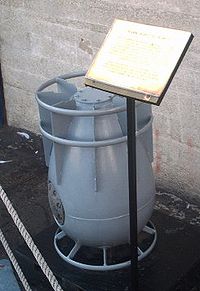
Photo from wikipedia
Abstract Molecular dynamics simulations of the electrical double layer at electrode–ionic liquid interfaces allow for molecular level interpretation of the interfacial phenomena and properties, such as differential capacitance (C). In… Click to show full abstract
Abstract Molecular dynamics simulations of the electrical double layer at electrode–ionic liquid interfaces allow for molecular level interpretation of the interfacial phenomena and properties, such as differential capacitance (C). In this work, we have simulated an ionic liquid – 1-butyl-3-methylimidazolium hexafluorophosphate – at three gold surfaces, namely: Au(100), Au(110), and Au(111) surfaces. Atomic corrugation of the gold surface leads to higher C values due to the rapprochement of the surface and electrolyte charge planes. Likewise, by accounting for the shift of surface charge plane position towards the electrolyte also results in higher C values. The presented insight shows that a simple correction to the simulation data improves the agreement with the experimental data.
Journal Title: Electrochimica Acta
Year Published: 2019
Link to full text (if available)
Share on Social Media: Sign Up to like & get
recommendations!